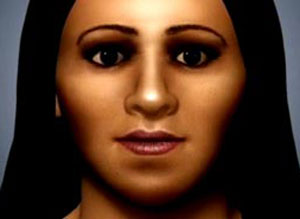Discovered the remains of Queen Cleopatra
Archaeologists believe they have found the remains of Queen Cleopatra's sister, who was murdered more than 2,000 years ago by her sister's orders .
Princess Arsinoe was murdered in 41 BC at the behest of Cleopatra and her lover Mark Antony. Arsinoe princess remains are the first Ptolemaic relics found by archaeologists.
The groundbreaking discovery by a group of archaeologists, sponsored by the Austrian Institute of Archeology, provided more evidence of Cleopatra's true origin. Scholars have long wondered, she is Greek, Macedonian or North African.
Evidence obtained during the study of the size of Princess Arsinoe's skull shows that Arsinoe has the characteristics of white Europeans, ancient Egyptians and even Africans. This helps scientists draw conclusions that Cleopatra may be a hybrid. Cleopatra and her sister may be the daughter of Ptolemy XII with many different wives.

Anthropologist Caroline Wilkinson proceeded to reconstruct the Princess Arsinoe's skull and face based on measurements from the 1920s.
The Austrian Institute of Archeology will publish details of the discovery during a seminar on anthropology in the US later this month.
Previously, archaeologists conducted an investigation to verify the hypothesis of Austrian scientist Hilke Thür, that an octagonal tomb in the Roman city of Ephesus contained the remains of the princess. Arsinoe. According to ancient Roman documents, the city is now located on the west coast of Turkey, where Arsinoe was banished after failing to fight power with Cleopatra and his lover, Julius Caesar. After Caesar's death, Cleopatra and Mark Antony ordered the murder of Arsinoe to eradicate the plot of the throne.
This tomb was first opened in 1926. At that time archaeologists found a sarcophagus containing a human skeleton. They took out the skull to check and measure. However, it was lost in the Second World War.
In the early 1990s, Hilke Thür went to the grave and found a headless skeleton that she believed belonged to a young girl. Evidence like the unusual shape of the tomb - 8 edges - reminds people of the Alexandria lighthouse often associated with the image of the Arsinoe princess, making the Hilke Thür believe this is Cleopatra's sister's remains.
Hilke's hypothesis is endorsed by many historians. In order to decipher this mystery, the Austrian Archaeological Institute asked an expert from the University of Medicine Vien (Austria) to test the remains of the tomb.
After using carbon dating, anthropologist Fabian Kanz - who tested more than 500 excavated skeletons from the Ephesus city ruins - confirmed skeletons dating back to 200- 20 BC and Hilke Thür's hypothesis are completely grounded.
This is certainly the bones of women aged 15-18. Although scientists do not know exactly the age of Arsinoe, Arsinoe is younger than Cleopatra. By the time Arsinoe died Cleopatra was about 27 years old. According to Fabian Kanz, Arsinoe has no signs of illness or malnutrition.
Another anthropologist, Caroline Wilkinson, reconstructed the lost skull and Princess Arsinoe's face based on measurements from the 1920s.
- Real story of the Egyptian queen Cleopatra
- The fate of the children of Queen Cleopatra
- Cleopatra scientist
- Cleopatra - the most powerful woman of the ancient world
- Excavation of Cleopatra's property under the ocean
- Discover the story of Cleopatra's queen
- Recreating the perfume of Queen Cleopatra 2,000 years ago
- Doubt about the death of the beautiful Egyptian queen
- Cleopatra - The first woman to
- Cleopatra committed suicide with poisonous snakes: Is it true or just a legend?
- Little is known about Cleopatra's queens
- The way to take care of Cleopatra's skin
 Discovered an ancient centipede fossil 99 million years old
Discovered an ancient centipede fossil 99 million years old Discovered bat-like dinosaurs in China
Discovered bat-like dinosaurs in China Discovered a 200-year-old bronze cannon of the coast
Discovered a 200-year-old bronze cannon of the coast Discover 305 million-year-old spider fossils
Discover 305 million-year-old spider fossils